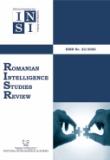REȚEAUA DE DEZINFORMARE „SPUTNIK” DE PE PLATFORMA TWITTER
'SPUTNIK' DISINFORMATION NETWORK ON THE TWITTER PLATFORM
Author(s): Adrian BarbuSubject(s): Media studies, International relations/trade, Security and defense, Politics and communication, Peace and Conflict Studies
Published by: National Institute for Intelligence Studies
Keywords: Disinformation; Propaganda; Russia; Twitter; Network; Sputnik;
Summary/Abstract: In an age where information means power, combat with weapons from the battlefields seems to have moved online. The main tools that actors use in the information battle are the same as those used hundreds of years ago - propaganda and disinformation, but the place in which they are promoted have been transformed due to technological developments. Now, the virtual environment and especially social media have become extremely attractive areas for those who want to promote fake messages in order to influence or mislead the opponent. Since 2011, with the anti-government protests in Russia, the Kremlin has invested heavily in the social media area, transforming it into an essential component of its information campaigns for the control, monitoring and influence of the virtual environment. Among the favorite targets of the actions subordinated to the information operations commanded from Moscow are the states in the immediate vicinity of the Russian colossus, respectively the states of Central Asia, the Caucasus, the Baltic states and Belarus, the Republic of Moldova and Ukraine, as well as the former communist states of Central Europe and of the East, including Romania. In the Romanian media, Sputnik Moldova-Romania is seen as the symbol of Russian propaganda. Not few were the cases in which journalists and Romanian experts proved how texts published on the news platform were created or cosmetized in order to mislead or generate favorable feelings for Moscow among readers. The Sputnik news agency, respectively its platform in Romanian, is one of the main promoters of Kremlin propaganda messages in the public space in Romania. This paper analyzes the way in which the most important representative of Russian propaganda in the local media acts in relation to Romanian online communities on the Twitter micro-blogging platform. In this regard, the activity of the Russian news agency's account has been assessed from a dual point of view: network analysis - how users coagulate around it and what are the characteristics of its ecosystem; content analysis – what are the main lines and messages diffused on the Twitter platform.
Journal: Romanian Intelligence Studies Review
- Issue Year: 2020
- Issue No: 23
- Page Range: 89-102
- Page Count: 14
- Language: Romanian

